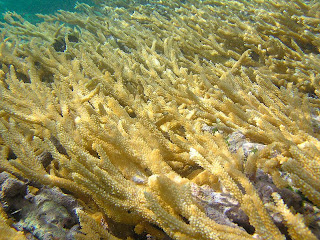 Stephen Leahy in IPS via Tierramérica: The waters of the Caribbean Sea are the warmest on record and the region's imperilled corals are bleaching and beginning to die, experts warn. This year many corals are already bleached and dying in the southern Caribbean Sea, especially in the Lesser Antilles, according to Mark Eakin coordinator of Coral Reef Watch at the U.S. National Oceanographic and Atmospheric Administration (NOAA).
Stephen Leahy in IPS via Tierramérica: The waters of the Caribbean Sea are the warmest on record and the region's imperilled corals are bleaching and beginning to die, experts warn. This year many corals are already bleached and dying in the southern Caribbean Sea, especially in the Lesser Antilles, according to Mark Eakin coordinator of Coral Reef Watch at the U.S. National Oceanographic and Atmospheric Administration (NOAA).The waters are even warmer than they were in 2005 when a severe bleaching occurred across much of the Caribbean. More than 60 percent of corals around the U.S. Virgin Islands died, Eakin told Tierramérica. Water temperatures in this region reach their annual peak between September and October.
The area affected by bleaching and dying corals will likely extend to the region east of Nicaragua, past the island of Hispaniola (Haiti and Dominican Republic) to Puerto Rico and the Lesser Antilles, and south along the Caribbean coasts of Panama and South America, according to a warning issued by Coral Reef Watch last month. "There is the potential that this will be worse than 2005, unless some tropical storms come through and mix the warm surface water with deeper, cooler water," Eakin said.
Coral reefs are found in less than one percent of the world's oceans but are home to 25 to 30 percent of all marine species. Some one billion people depend directly and indirectly on reefs for their livelihoods. The International Union for Conservation of Nature (IUCN) considers coral reefs one of the life-support systems essential for human survival….
Healthy Acropora prolifera coral, photographed by Mark Eakin of NOAA near Lee Stocking Island, Bahamas



No comments:
Post a Comment